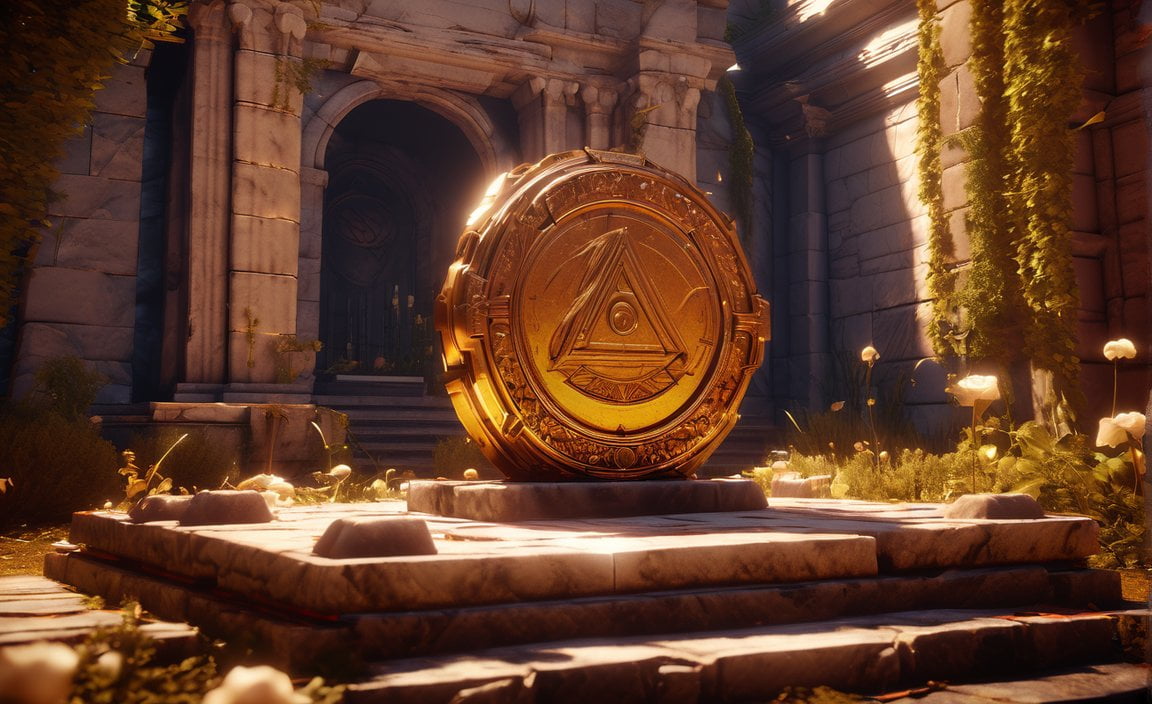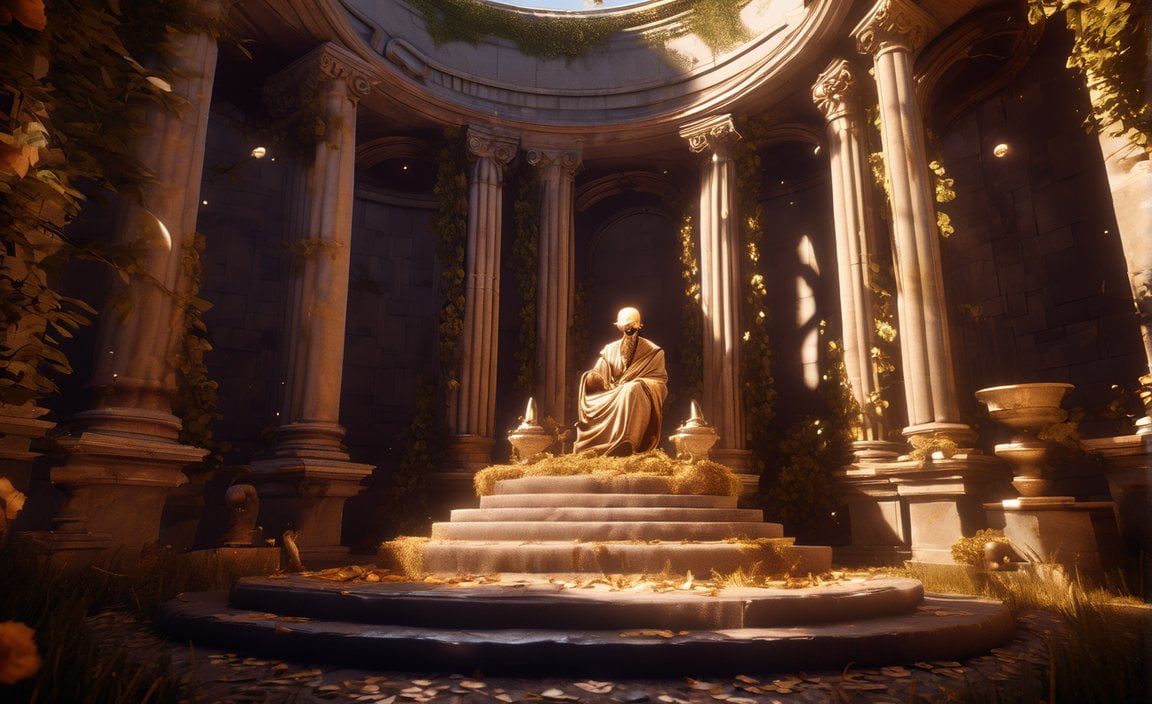Unveiling Archimedes’ Grave: Ancient History’s Hidden Treasure – Join us on an extraordinary journey as we delve into the enigmatic world of Archimedes’ grave. As seasoned archaeologists with a deep passion for ancient history, we are thrilled to share the intriguing tale of one of history’s greatest minds and the mysteries surrounding his final resting place. Join us as we unravel the secrets and uncover the potential historical implications of this incredible discovery.

Key Takeaways:
- Archimedes of Syracuse was a renowned Ancient Greek mathematician, physicist, engineer, astronomer, and inventor, considered the greatest mathematician of ancient history.
- He made significant contributions to various fields, including mathematics, physics, and engineering, and is best known for his principle of buoyancy.
- The location of Archimedes’ tomb has been a subject of much speculation and interest, with various legends and theories surrounding it.
- Despite efforts to locate it, the exact whereabouts of Archimedes’ final resting place remain unknown.
- Archimedes’ work has had a lasting impact on scientific development, particularly in the fields of mathematics, physics, and engineering.
- Today, Archimedes is remembered as one of the greatest mathematicians and scientists of all time, with his principles and discoveries continuing to inspire further research and exploration.
Archimedes’ Grave: Unraveling the Mystery
Throughout history, there are moments when the past tantalizes us, leaving behind a trail of riddles waiting to be solved. One such enigma lies in the search for the final resting place of Archimedes, the legendary Greek mathematician and scientist. Despite the passage of centuries and countless archaeological endeavors, his grave remains shrouded in mystery. Join me on a journey as we explore the lingering questions and potential implications surrounding Archimedes’ elusive tomb.
The Genius of Syracuse
Archimedes, a genius born in 287 BC, hailed from the ancient city of Syracuse in Sicily. He emerged as one of the greatest mathematicians in history, making significant contributions to various scientific fields. His discoveries in mathematics, physics, and engineering continue to shape our understanding of the world today.
A Tomb Lost in Time
The search for Archimedes’ grave has captivated the minds of scholars and historians for centuries. According to legend, after his death during the Roman siege in 212 BC, Archimedes was laid to rest in front of the gate to Agrigento in Syracuse. However, actual evidence supporting this claim has remained elusive.
Intriguingly, a tomb initially thought to be that of Archimedes turned out to be a Roman columbarium, a burial chamber from a later period. This discovery raised more questions than answers, leaving us to wonder where Archimedes may truly lie.
A Historian’s Dilemma
As historians, our quest is not solely to uncover physical remains but also to grasp the significance of their existence. The absence of a confirmed burial site for Archimedes presents us with a unique challenge. It tests our ability to piece together fragments of history while acknowledging the gaps that remain.
Within this void, our collective knowledge and imagination intertwine. We speculate on the whereabouts of Archimedes’ tomb, draw from ancient texts, and meticulously pore over archaeological evidence. Yet, the final puzzle piece has eluded us thus far, preserving the intrigue and allure of this unsolved mystery.
Legacy Preserved: A Testament to the Greatness
Amidst the enigma surrounding Archimedes’ grave, one truth remains unwavering – his enduring legacy. His mathematical prowess, revolutionary principles, and engineering innovations continue to influence scientific thought and practice. Archimedes’ contributions extend far beyond his own lifetime, shaping the progress of subsequent generations.
As we navigate the intricacies of history, we are reminded that the search for physical remains is not the sole measure of a person’s impact. Archimedes’ tomb may elude us, yet his profound influence remains ever-present, inspiring new discoveries and fostering a thirst for knowledge.
Concluding Thoughts
In the world of archaeology, some quests may never find resolution. Archimedes’ final resting place stands as one such enigma, teasing us with its mystery. While we yearn for closure, we must also recognize the inherent beauty in the unanswered questions. They challenge us to ponder, explore, and push the boundaries of our understanding.
As we continue to delve into the depths of ancient history, driven by our insatiable curiosity, the elusive tomb of Archimedes stands as a testament to the limits of our knowledge. With every excavation, every text scrutinized, we inch closer to unravelling the secrets that time has enshrouded. One day, perhaps, the location of Archimedes’ grave shall be laid bare, unlocking a new chapter in his remarkable story.
So, as we embrace the thrill of the unknown, let us journey forth, seeking answers, and embracing the immeasurable wonders that history holds.
In the fascinating world of Native American culture, the Blackfoot Tribe clothing holds a distinct charm and significance. Explore more about the traditional attire of the Blackfoot Tribe by clicking here.
Discover the remarkable leadership of the rightly guided caliphs and their influential role in Islamic history. Click here to delve into the remarkable tales of these eminent leaders.
In the intriguing Inca society, the Sapa Inca served as a prestigious position with immense responsibilities. Uncover their pivotal role and importance by clicking here.
Efforts to locate Archimedes’ grave throughout history
Throughout history, the search for the final resting place of the renowned mathematician and inventor Archimedes has captivated the minds of archaeologists and historians alike. Efforts to locate Archimedes’ grave have spanned centuries, but the exact location of this elusive tomb remains shrouded in mystery. Let’s delve into the fascinating journey of uncovering the final resting place of this brilliant ancient scholar.
Archimedes’ Tomb: An Enigma in Ancient History
Archimedes, born in 287 BC in Syracuse, Sicily, made significant contributions to mathematics, physics, and engineering. He was revered for his groundbreaking discoveries, such as the concept of buoyancy known as Archimedes’ principle and the invention of the Archimedes’ screw. Despite his incredible impact on the scientific world, the whereabouts of his burial site have remained a riddle through the ages.
Uncovering Clues in Historical Accounts
One of the earliest accounts of Archimedes’ grave comes from the Roman writer Cicero. He claimed to have discovered the tomb, describing inscriptions depicting a stone cylinder and sphere on the monument. However, Cicero failed to provide specific details about the tomb’s location, leaving subsequent generations of researchers with the daunting task of deciphering this puzzle.
Theories and Speculations: A Journey of Discovery
Over the years, various theories have emerged regarding the possible sites of Archimedes’ grave. One hypothesis suggests that the tomb may be located in the Necropoli Grotticelli, an ancient Roman catacomb in Syracuse. Advocates of this theory argue that the “Archimedes’ Grave” within the catacomb is the mathematician’s final resting place. However, concrete evidence supporting this claim has yet to be found, leaving this theory in the realm of speculation.
Another theory proposes that the tomb is situated within the Archaeological Park of Syracuse. This theory finds support in the existence of a building labeled as “Archimedes’ grave” within the park. However, it is widely believed that this structure is not the actual tomb of Archimedes but rather a Roman catacomb constructed long after his death.
The Elusive Nature of Archimedes’ Tomb
The quest to pinpoint Archimedes’ grave presents a unique challenge. The lack of definitive evidence and conflicting historical accounts leave room for speculation and imagination. Historians and archaeologists must piece together fragments of history in their tireless pursuit to solve this ancient mystery.
Archimedes’ Legacy Lives On
While the tomb’s location may remain unknown, Archimedes’ legacy continues to inspire and fascinate people to this day. His remarkable contributions to mathematics, physics, and engineering have left an indelible mark on the world. The principles and inventions attributed to Archimedes continue to shape our understanding of the natural world and serve as a testament to his brilliance.
Key Takeaways:
- Archimedes’ tomb has long fascinated archaeologists and historians.
- Clues about the tomb’s location come from the ancient accounts of Cicero.
- Theories propose different possible sites, such as the Necropoli Grotticelli and the Archaeological Park of Syracuse.
- The elusive nature of the tomb leaves room for speculation and imagination.
- Despite the mystery surrounding his grave, Archimedes’ contributions to science and innovation remain significant and influential.
Sources:
– The Italian Academy: The Curious Case of the Tomb of Archimedes
– Ancient Origins: Cicero and the Forgotten Tomb of Archimedes
Recent Breakthroughs in the Search for Archimedes’ Grave
The Quest for History’s Hidden Treasure
Archimedes, the renowned mathematician and scientist of ancient Greece, has left an indelible mark on the world with his groundbreaking contributions to mathematics, physics, and engineering. However, even after centuries of searching and numerous archaeological efforts, the location of his final resting place remains a mystery. The elusive tomb of Archimedes has captivated scholars and history enthusiasts alike, sparking an ongoing quest to unveil this hidden treasure.
Unearthing the Secrets
Recent breakthroughs in the search for Archimedes’ grave have reinvigorated the pursuit of this historical enigma. Scholars, archaeologists, and historians are tirelessly exploring various sources of information to shed light on the tomb’s location and unravel the mysteries that shroud Archimedes’ burial site.
One such source is The Italian Academy’s website, which offers unique insights into the efforts and research conducted by this organization dedicated to preserving Italian cultural heritage[^1^]. The academy has actively participated in the exploration of the Archaeological Park of Syracuse in Italy, a potential location for Archimedes’ tomb. This park, filled with graves from ancient Greek, Roman, and Byzantine periods, provides a promising backdrop for discovering the mathematician’s final resting place.
Another valuable resource is an article on Ancient Origins, which recounts Cicero’s discovery of the tomb and the ensuing controversy surrounding its existence[^2^]. Cicero, a Roman writer, encountered inscriptions depicting a stone cylinder and sphere on the monument, hinting at the tomb’s remarkable features. However, he did not provide specific details about its precise location, adding to the mystery.
Recent Progress and Future Prospects
In light of recent breakthroughs, the search for Archimedes’ grave has gained new momentum. Scholars and archaeologists have meticulously studied the historical accounts and conducted thorough research to narrow down potential sites within the Archaeological Park of Syracuse.
Despite the lack of definitive evidence, one theory proposes that the tomb might be located in Necropoli Grotticelli, an area within the park that showcases graves from the Hellenistic and Roman periods. This theory suggests that this ancient burial ground may hold the key to unraveling the secrets of Archimedes’ final resting place.
However, the quest for Archimedes’ grave is far from over. The challenges posed by conflicting historical accounts and the absence of concrete evidence continue to fuel speculation and intrigue. Nevertheless, the determination to uncover the tomb remains unwavering, as scholars recognize the historical significance and potential implications of its discovery.
Key Takeaways:
- The location of Archimedes’ grave has long remained a mystery, captivating scholars and history enthusiasts worldwide.
- Recent breakthroughs in the search for Archimedes’ grave have reinvigorated the quest to unveil this hidden treasure.
- The Italian Academy, dedicated to preserving Italian cultural heritage, has actively participated in research and exploration within the Archaeological Park of Syracuse, a potential location for Archimedes’ tomb[^1^].
- Ancient Origins provides insights into Cicero’s discovery of the tomb and the controversy surrounding its existence[^2^].
- The search for Archimedes’ grave faces challenges due to conflicting historical accounts and lack of concrete evidence.
- Despite the obstacles, scholars and archaeologists remain determined to uncover the tomb and shed light on Archimedes’ final resting place.
Source 2: Ancient Origins
Potential findings and future research opportunities related to Archimedes’ grave
Archaeological mysteries have the power to captivate our imaginations and spark the desire for discovery. The tomb of Archimedes, an ancient Greek mathematician and scientist, is one such enigma. The search for his final resting place has remained elusive, shrouded in historical uncertainties and conflicting accounts. However, the quest for Archimedes’ grave holds immense potential for future findings and research opportunities, which could shed light on one of history’s most influential figures.
Tracing History’s Footsteps
The exploration of Archimedes’ tomb presents an opportunity to delve into the historical legacy of Syracuse, the city in which he lived. By tracing the footsteps of this renowned mathematician, we may unearth valuable artifacts and gain deeper insights into the life and times of ancient Greece. Through meticulous excavation and careful analysis, we can piece together the puzzle of Archimedes’ burial site, potentially revealing long-lost treasures that have the power to reshape our understanding of this remarkable era.
Unearthing Architectural Marvels
Archimedes’ grave, wherever it may be located, holds the promise of architectural wonders waiting to be discovered. As a brilliant innovator in mathematics and engineering, Archimedes left behind a legacy of groundbreaking inventions that revolutionized the ancient world. Imagine the thrill of uncovering artifacts linked to his mathematical processes and boundary objects, offering tangible evidence of his genius. Exploring his tomb could reveal intricate models, designs, or prototypes showcasing Archimedes’ visionary mind, providing valuable insights into his problem-solving techniques.
Decoding Epigraphical Clues
One of the most exciting aspects of uncovering Archimedes’ grave is the possibility of decoding epigraphical clues. Ancient inscriptions, symbols, or writings found within the tomb could offer invaluable information about Archimedes’ life and contributions. These artifacts have the potential to enhance our understanding of his mathematical theorems, uncovering further secrets hidden within his work. Through careful analysis and collaboration with experts in ancient languages, we may be able to decipher inscriptions that provide new insights into Archimedes’ methodologies and scientific discoveries.
Investigating Syracusan Negligence
Cicero’s accusation of Syracusan negligence in relation to Archimedes’ tomb raises intriguing questions. Exploring this historical controversy and investigating whether there is any truth to Cicero’s claims could provide fascinating research opportunities. Were the Syracusans truly negligent in preserving Archimedes’ final resting place? By examining historical records, studying the politics of the time, and analyzing the city’s cultural landscape, researchers can shed light on the motivations and circumstances that led to the tomb’s disappearance. This investigation could provide valuable insights into the cultural memory and attitudes of the ancient Syracusans.
Advancing Archaeological Techniques
The search for Archimedes’ grave offers a chance to apply the latest technological advancements in archaeology. From ground-penetrating radar to LiDAR scanning, these cutting-edge techniques could help researchers identify potential burial sites or hidden chambers. Furthermore, novel methods of artifact analysis, such as nondestructive spectroscopy or isotopic analysis, could enhance our understanding of the materials used in Archimedes’ time. By embracing technological advancements, archaeologists can push the boundaries of knowledge, fostering innovation in their field and potentially revolutionizing our understanding of ancient history.
Key Takeaways:
- The quest for Archimedes’ grave holds immense potential for future findings and research opportunities.
- Exploring his tomb could reveal valuable artifacts, offering insights into Archimedes’ life and the ancient Greek world.
- Unearthing architectural marvels linked to Archimedes’ engineering inventions may provide valuable insights into his problem-solving techniques.
- Decoding epigraphical clues found within the tomb could enhance our understanding of Archimedes’ mathematical theorems and scientific discoveries.
- Investigating the historical controversy surrounding Syracusan negligence could shed light on ancient cultural attitudes.
- Advancements in archaeological techniques, such as ground-penetrating radar and nondestructive spectroscopy, could revolutionize our understanding of Archimedes’ era.
Sources:
- The Italian Academy – The Curious Case of the Tomb of Archimedes
- Taylor & Francis Online – Archimedes’ legacy for early modern science: Historical Perspective

FAQ
Q1: Where is Archimedes’ grave located?
A1: The exact location of Archimedes’ grave remains unknown, with various theories suggesting different sites in Syracuse, Italy. Concrete evidence to confirm these claims is lacking.
Q2: Who discovered Archimedes’ tomb?
A2: According to ancient accounts, the tomb was discovered by Cicero during his time in Sicily serving as a quaestor. However, the Syracusans denied the existence of the tomb and were unaware of its location.
Q3: What is the significance of Archimedes’ tomb?
A3: Archimedes’ tomb is a historical mystery that adds intrigue to the city of Syracuse and serves as a testament to the enduring legacy of the renowned mathematician and inventor.
Q4: What are some theories about the location of Archimedes’ tomb?
A4: One theory suggests that the tomb is located in the Necropoli Grotticelli, an ancient Roman catacomb in Syracuse. Another theory proposes that the tomb is situated in the Archeological Park of Syracuse. However, these claims lack concrete evidence.
Q5: What were Archimedes’ contributions to mathematics and science?
A5: Archimedes made significant discoveries and inventions in fields such as mathematics, physics, and engineering. Some of his remarkable inventions include the Archimedes’ screw and the principle of buoyancy known as Archimedes’ principle.
- Senior at What Age: Benefits & Eligibility Guide - March 29, 2025
- Unlocking Senior Benefits: How Old is a Senior? Your Complete Guide - March 29, 2025
- Master Russian Politeness:A Guide to Saying Please - March 29, 2025
















